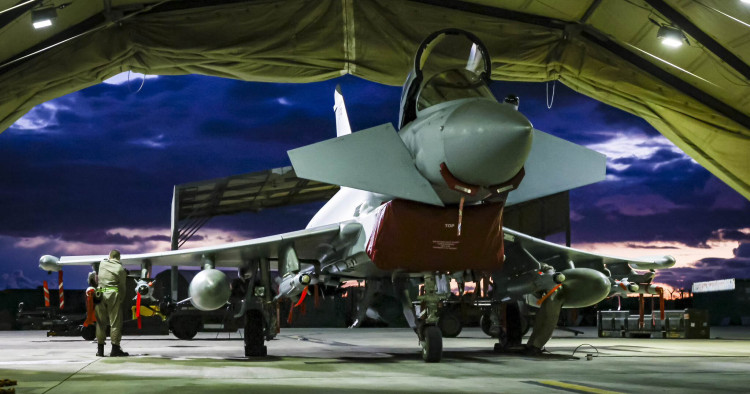Contents:
- US lashes out at Iranian militia proxies, but those strikes will not deter Tehran or its regional network
- Iraqi government balances desire to preserve military cooperation with US versus influence of local militias
- A long "to-do" list for Blinken’s latest Middle East trip
- Biden’s executive order on settler terror is potentially far-reaching
- Pre-electoral machinations in Pakistan
- A year after devastating earthquakes, Turkey’s recovery lags, but Erdoğan suffers few political costs
- EU steps up to Houthi maritime threat, but Operation Aspides may not be a game changer
US lashes out at Iranian militia proxies, but those strikes will not deter Tehran or its regional network
Charles Lister
Senior Fellow, Director of Syria and Countering Terrorism & Extremism programs

-
Last week, the United States conducted the most expansive military action against Iran’s militia network since the Iraq War; but the five-day delay in launching the strikes meant that all Iranian IRGC personnel had evacuated, along with militia commanders and leaders.
-
For now, this appears to be in keeping with the Biden administration’s desire to avoid targeting Iran or Iranians specifically — a strategy that does little except feed Iranian confidence that its long-term proxy-driven attritional campaign against the US is working.
In launching a wave of strikes on Iranian proxy militant targets in western Iraq and eastern Syria late on Feb. 2, the United States conducted the most expansive military action against Iran’s militia network since the Iraq War — hitting 85 targets with 125 munitions. Of the 34 confirmed fatalities, all were locals, except four Afghan members of Liwa Fatemiyoun (an Afghan Shi’a force founded and supported by Tehran). The US attacks were in response to a Jan. 28 drone assault by Iranian militia forces in Syria that killed three American troops based in Jordan.
Taken in isolation, the US strikes were unquestionably significant, but if the Biden administration hoped that Iran and its proxies would be deterred, they were wrong. Three new attacks targeting US troop positions were recorded the following day, on Feb. 3 (two in Syria and one in Iraq); and late on Feb. 4, an Iranian-made suicide drone precisely struck a building housing the US-trained commando unit of the Syrian Democratic Forces (SDF) inside the al-Omar US military base in Deir ez-Zor, Syria. Seven SDF commandos were killed and 18 more injured. Beyond attacks, the entire Iranian proxy propaganda network swiftly returned to online service — disseminating threats, news, and attack claims — after having gone completely offline in the days prior to the strikes.
The fact that it took five days for the strikes to occur ensured that all Iranian Islamic Revolutionary Guard Corps (IRGC) personnel had evacuated, along with militia commanders and leaders. The only militia personnel left behind were night guards. While stores of Iranian-made drones and rockets were destroyed, Iran’s most valuable assets — commanders and operatives — survived, safe to fight another day. For now, this appears to be in keeping with the Biden administration’s desire to avoid targeting Iran or Iranians specifically — a strategy that does little except feed Iranian confidence that its long-term proxy-driven attritional campaign against the US is working.
That the strikes were conducted by long-range B-1 bombers flown directly from California served to underline another Iranian advantage. Purposely avoiding the use of air or naval assets pre-positioned in bases across the Middle East was a clear recognition that America’s regional allies and partners want no association with the strikes — out of concern that Tehran could direct its proxies to target them in response. Such attacks, whether launched from Iraq or Yemen, have happened before, and the resulting deterrent effect clearly remains to Iran’s advantage.
Follow on Twitter: @Charles_Lister
Iraqi government balances desire to preserve military cooperation with US versus influence of local militias
Randa Slim
Senior Fellow and Director of Conflict Resolution and Track II Dialogues Program

-
Until now, Iraqi Prime Minister Mohammed al-Sudani has been trying to balance between hardliners in his coalition who are calling for a quick withdrawal of US forces and others who see that a rupture in the US-Iraqi relationship will harm their economic interests.
-
However, if the US bombing campaign against Tehran-backed militias continues to kill more Iraqis and eventually escalates to target Iranian personnel in or outside Iran, then Sudani’s balancing act could become unsustainable.
Last Friday, Feb. 2, the United States struck dozens of command-and-control as well as weapons storage and production facilities of Iranian-backed militias in Syria and Iraq, killing 16 people in the latter country. In its reaction to the US attack, the Iraqi state administration governing coalition, which includes leaders of several Iran-affiliated militias, notably struck a balanced tone. On one hand, it condemned the US targeting of bases of the Popular Mobilization forces (PMF), describing it in a statement as “a serious attack on an official Iraqi security institution” and “a violation of Iraq’s sovereignty and security and a transgression of international norms and law.”
Interestingly, however, it did not stridently comment on the US military presence in Iraq. Rather, the governing coalition expressed support for the ongoing bilateral dialogue regarding the potential withdrawal of US armed forces. The statement also rejected “all forms of attacks targeting Iraqi military bases as well as targeting military advisors from international coalition countries,” which include US uniformed personnel.
On Sunday, Feb. 4, White House national security spokesperson John Kirby said, “We also want to see the Iraqi government move with more alacrity to help us rid the threat of these militia groups on Iraqi soil. …these groups are operating with some manner of impunity on Iraqi soil.” Like his predecessors, Iraqi Prime Minister Mohammed al-Sudani cannot get rid of these militias or force them to change their behavior; they answer to an Iranian agenda that is not Iraq-specific. As long as these militias’ actions serve Tehran’s agenda, there are severe limits to what the Iraqi government can do to rein them in. There are also severe limits to what the Iraqi public can do. When Iraqis rose up in October 2019, demanding a state that guarantees their security and respects their rights, and called on Iran to leave Iraq, Iran-affiliated Iraqi militias killed hundreds of Iraqi youth protesters.
Those and more recent militia attacks have brought to the fore fears shared by many Iraqis that the security vacuum that will be created by the withdrawal of US forces will be filled by local Iran-aligned militias, thus strengthening their hold on the country. Until now, the Iraqi prime minister has been trying to balance between hardliners in his coalition who are calling for a quick withdrawal of US forces and others who see that a rupture in the US-Iraqi relationship will harm their economic interests. Hence, the prime minister’s strategy has been to initiate discussions about ending the current mission of the coalition forces, including the US, while negotiating bilateral security relationship with the member states — again, including the US. The above-cited, carefully worded statement issued by the governing coalition following Friday’s US attacks reflects this approach. However, if the US bombing campaign continues to kill more Iraqis and eventually escalates to target Iranian personnel in or outside Iran, then Prime Minister Sudani’s balancing act could become unsustainable.
On Feb. 5, Sudani met with Ali Akbar Ahmadian, the secretary of Iran’s Supreme National Security Council, on the latter’s first official visit to Iraq. The readout of the meeting from the prime minister’s office stated, “The prime minister emphasized Iraq’s rejection of any unilateral actions by any country … [and] Iraq’s commitment to the principle of good neighborliness … but such pursuits should not compromise Iraq’s sovereignty and security.”
It remains to be seen how the US bombing campaign will impact the Iran-aligned Iraqi militias’ behavior. Kataib Hezbollah, an Iraqi militant group responsible for the attack on the US outpost in Jordan that killed three US soldiers, already suspended its targeting of American forces. But Harakat Hezbollah al-Nujaba, another member of the Islamic Resistance in Iraq, an umbrella organization that includes several Iran-affiliated Iraqi militias, vowed to continue striking US troops in theater. The umbrella group has conditioned the end of its attacks on a cease-fire in Gaza. But the challenges these militias pose for Iraqi sovereignty predate the Gaza war and will continue after it ends.
Follow on Twitter: @rmslim
A long “to-do” list for Blinken’s latest Middle East trip
Brian Katulis
Vice President of Policy

-
US Secretary of State Antony Blinken is currently meeting leaders and counterparts across the region to reinforce ongoing diplomacy toward achieving a longer-term cease-fire in the Israel-Hamas war, secure the release of hostages held in Gaza, increase the flow of humanitarian aid to Palestinians, shore up the Palestinian Authority, and set a new framework for Israeli-Palestinian peace, among other aims.
-
Juggling so many objectives at the same time has inherent risks: If everything is a priority, then nothing may end up being a top priority, making it difficult to achieve progress toward any of America’s stated goals.
US Secretary of State Antony Blinken is on his fifth trip this week to the Middle East since the Israel-Hamas war began. The current itinerary plans to take him to Saudi Arabia, Egypt, Qatar, Israel, and the West Bank. The main focus is on helping advance a much-anticipated longer-term pause in the fighting between Israel and Hamas in exchange for the release of more hostages held in the Gaza Strip.
This latest visit comes after the United States stepped up its airstrikes against Iran-backed groups in Yemen, Syria, and Iraq in retaliation for attacks on shipping in the Red Sea and a drone strike that killed three US soldiers in Jordan last week. The Biden administration is hoping to avoid further regional escalation that would put the US more directly in conflict with Iran as it seeks to strike the right balance in its attacks on Iran-backed forces.
These regional tensions shape the broader context for Blinken’s ongoing diplomatic efforts, which so far have yielded limited progress. The Israel-Hamas war has raged for nearly four months, except for a one-week pause in fighting and release of hostages in late November. The humanitarian crisis inside of Gaza remains quite dire, and Biden’s National Security Advisor Jake Sullivan said this weekend that in addition to the other things Blinken will try to achieve, “a top priority” of the secretary of state in meeting the Israeli government is to make clear that “the needs of the Palestinian people […] are going to be front and center in the US approach and that we want to ensure that they are getting access to life saving food, medicine, water, [and] shelter.”
Additionally, the Biden administration wants to use a longer-term cease-fire to pursue wider Middle East peace deals, including a two-state solution that would somehow preserve the idea of a normalization of relations between Israel and Saudi Arabia as a prospect for 2024, an election year. US officials have apparently briefed columnists like Thomas Friedman and David Ignatius on quite grandiose visions of what might happen if the pieces fall into place for a cease-fire and hostage release.
Ultimately, the facts on the ground, including the unpredictable dynamics of multiple conflicts in the Middle East and the will, intentions, and capacities of the main combatants, will determine whether any of these designs ultimately succeed. Blinken’s latest diplomatic shuffle across the region has high ambitions and a long to-do list, but juggling so many objectives at the same time presents inherent risks. If everything is a priority, then nothing may end up being a top priority, making it difficult to achieve progress toward any of America’s many objectives.
Follow on Twitter: @Katulis
Biden’s executive order on settler terror is potentially far-reaching
Khaled Elgindy
Senior Fellow, Director of Program on Palestine and Palestinian-Israeli Affairs

-
Israeli settler terrorism in the occupied West Bank and East Jerusalem has reached unprecedented levels since Oct. 7, with nearly 500 attacks against Palestinians, killing at least eight and injuring more than 117 others as well as displacing some 1,200.
-
President Joe Biden’s executive order allowing the US to sanction perpetrators of this violence could have far-reaching implications if it is not too narrowly applied, and particularly if it is combined with new foreign terrorist organization (FTO) designations against extremist groups.
Last Thursday, Feb. 1, President Joe Biden signed an executive order allowing the United States to impose new sanctions on individual Israeli settlers involved in terrorism and other violent attacks against Palestinians in the occupied West Bank, presumably including East Jerusalem. White House officials say Israeli settler violence of this sort in the Occupied Territories has reached “intolerable” levels. The order freezes the US-based assets and bank accounts of designated individuals and prohibits trade or financial transactions with them, as well as bars them from entering the United States. Settler terrorism, which had already spiked throughout 2023, has reached unprecedented levels since Oct. 7. Extremist Israeli settlers have carried out nearly 500 attacks against Palestinians since Oct. 7, killing at least eight Palestinians, including a child, and injuring more than 117 others, according to the United Nations. Settler terrorism has also led to the displacement of some 1,200 Palestinians. Biden’s executive order names four individuals implicated in recent violent attacks on Palestinians, including the February 2023 settler pogrom on the northern West Bank village of Huwara, in which one Palestinian was killed.
While some have described the move as “the most significant step any U.S. administration has ever taken” to confront settler terrorism, previous administrations have taken the considerably more powerful step of designating Israeli extremist groups as foreign terrorist organizations (FTO). In 1995, President Bill Clinton designated two of them, Kach and Kahane Chai, both inspired by the radical rabbi Meir Kahane, as FTOs. Ironically, it was the Biden administration that removed both groups from the FTO list in May 2022, just months before Itamar Ben-Gvir’s Otzma Yehudit (“Jewish Power”) Party, an offshoot of the Kahanist movement, joined the ruling coalition.
Nevertheless, last week’s measure could have potentially far-reaching implications for settler violence and the settler movement as whole if additional individuals are added — particularly if they include Israeli politicians and government officials, given the close cooperation between the Israeli army, government ministries, and violent settlers. In meantime, as long as this potentially powerful tool is narrowly applied to only a handful of individuals, and particularly in the absence of new FTO designations, the executive order is unlikely to have a significant impact on the ground.
Follow on Twitter: @elgindy_
Pre-electoral machinations in Pakistan
Syed Mohammad Ali
Non-Resident Scholar

-
While former Prime Minister Imran Khan has been removed as a challenger, the exact contours of the power structure likely to emerge from the Feb. 8 elections are as yet unclear.
-
No matter what the exact outcome, the military will remain a key power broker, exerting even more influence on Pakistan’s foreign, economic, and domestic security policies.
With elections scheduled for Feb. 8, the political drama in Pakistan is in a frenzied state right now. While the electoral stage has been set in the broader sense, the jostling between a medley of ambitious politicians is on full display. The fact that former Prime Minister Imran Khan was going to be kept off the “pavilion” this time around has already been assured by his imprisonment and ban from public office; what remains uncertain is what the exact contours of the emergent power structure will be.
Here we need to consider the numbers game. For instance, will the military establishment’s currently favored (and last time around most disfavored) political party, the Pakistan Muslim League-Nawaz (PML-N), manage to secure a clear majority in parliament, or not? Whether the PML-N forms a coalition with the Pakistan People’s Party (PPP) will depend on how well the PPP does beyond its long-time power base in the province of Sindh. The PPP scion, Bilawal Bhutto Zardari, foreign minister under the Shehbaz Sharif-led PML-N government that followed Imran Khan’s ouster, makes that a possibility with precedent. Such a coalition would undoubtedly be shaky, and it is also unlikely given that disgruntled liberal and progressive sentiments may be split between the PPP and Pakistan Tehreek-e-Insaf (PTI), and its incarcerated leader, Imran Khan.
The electoral showdown in the Punjab may be fierce, among all major parties, but between the PML-N and the PTI in particular. The northern Khyber Pakhtunkhwa Province and the (former) Federally Administered Tribal Areas adjoining the Afghan border are being forecast as a sure win for PTI-aligned independent candidates. It would be intriguing if the PPP were compelled to join the PTI on the opposition benches, if the PML-N somehow manages to form alliances with smaller parties to cobble together its own government. How the religio-political right will do, under the banner of the rightist Jamaat-e-Islami and the aggressive Barelvi movement-affiliated Pakistan Tehreek-e-Labaik, also remains to be seen. All in all, as elections are now just around the corner, all we know for sure is that no matter what the exact outcome, the military will remain a key power broker, exerting even more influence on the country’s foreign policies, on its economy, and on security policies at home.
A year after devastating earthquakes, Turkey’s recovery lags, but Erdoğan suffers few political costs
Howard Eissenstat
Non-Resident Scholar

-
The devastating February 2023 earthquake sharply focused attention on the cronyism and corruption that have helped fuel Turkey’s domestic construction sector and, with it, much of the economic growth that is so central to the ruling party’s political brand.
-
But President Recep Tayyip Erdoğan and his governing coalition have yet to face a political reckoning because the authorities were able to shape the narrative around the disaster, silence criticism, shift blame to a handful of construction contractors, and connect disaster relief to electoral clientelism; thus, the ruling party looks set to win big in the upcoming municipal elections.
This week marks the one-year anniversary of the Feb. 6, 2023, earthquakes that devastated Turkey and Syria, killing more than 52,000 people and destroying millions of buildings. As in any major disaster, the weaknesses of the system were laid bare. In Syria, the response to the earthquake highlighted the near total lack of state structures in the northern parts of the country. In Turkey, the earthquake sharply focused attention on the cronyism and corruption that have helped fuel the domestic construction sector and, with it, much of the economic growth so central to the ruling Justice and Development Party’s (AKP) political brand.
For those directly affected, of course, the pain of last year’s earthquakes lingers. Whole families were wiped out, and more than a thousand children were orphaned. Millions were scarred, either physically or from psychological trauma; a recent study suggested that more than half of Turkish survivors suffer from some level of post-traumatic stress. According to Save the Children, “[About] 2.4 million people, including 660,000 children, were forced from their homes into temporary settlements… One year on, over 761,000 people, including 205,000 children, are yet to return home.” The international aid group adds, “While Turkish authorities are trying to move people to formal housing areas, almost half (355,000) of those displaced are in informal, unregulated sites, often made up of small tents or containers made of plastic and metal, some as small as 3x7 metres [approximately 10 by 23 feet].”
Despite the mixed success of Turkey’s rebuilding efforts, it is not at all clear that President Recep Tayyip Erdoğan or his ruling coalition have faced serious political blowback from the governmental response or from the corruption and mismanagement that so profoundly exacerbated the disaster in the first place.
There are at least four reasons for this. First, the authorities were successful in framing the earthquake as something so large that no government could respond effectively, describing it repeatedly as “the disaster of the century.” Second, and relatedly, the Erdoğan government leveraged its control over almost all broadcast media in Turkey to show itself in a favorable light (relatedly, it also arrested some for sharing negative social media posts about its response). Third, officials shifted blame for lax oversight and cozy deals between bureaucrats and construction firms by targeting a handful of contractors for shoddy construction. Fourth, and perhaps most importantly, Erdoğan made the case that voting for his coalition would help ensure aid, whereas voting for the opposition would risk it. As Turkey approaches municipal elections, scheduled for March of this year, Erdoğan has doubled down on this “call to clientelism,” telling voters in Hatay that they could only ensure support by voting for the governmental coalition. Opposition supporters have recently been quoted saying their chances of holding onto the traditional Republican People’s Party (CHP) stronghold are “slim.”
The devastation of last year’s earthquake continues to echo today, and hundreds of thousands still have no permanent home. The Turkish economy still struggles with high inflation and the recent resignation of Hafize Gaye Erkan, the fifth head of Turkey’s central bank to leave the post in the past five years, is unlikely to boost investor confidence. As Turkey enters municipal elections season next month, however, there are few signs that Erdoğan has much reason for concern.
EU steps up to Houthi maritime threat, but Operation Aspides may not be a game changer
Emiliano Alessandri
Non-Resident Scholar

-
While the otherwise militarily modest EU has a solid track record when it comes to maritime operations, the combined military and political deterrent of its proposed Red Sea security initiative is likely to be small overall.
-
Operation Aspides will remain a relatively minor factor in a much larger and more complex security equation that will not be solved until there is a political breakthrough around the war in Gaza.
The European Union’s soon-to-be launched Red Sea naval mission “Aspides” is, at face value, a very sensible initiative to confront the growing threat posed by sea-based attacks carried out by the Houthi militia in Yemen. EU trade critically depends on freedom of navigation through the Bab el-Mandab Strait, a crucial artery accounting for around 12% of global seaborn trade — a percentage that doubles when it comes to goods and commodities to and from the European continent. And if there is one field in which the otherwise militarily modest EU has showed its teeth in recent decades it is precisely Common Security and Defense Policy (CSDP) maritime operations. The counter-piracy Operation Atalanta, off the coast of Somalia (ongoing since 2008), and the anti-trafficking Operation Sophia, in the Mediterranean Sea (replaced in 2020 by the narrower Operation Irini), offer a solid track record.
Yet, as justified as it may be, Operation Aspides will hardly provide commercial ships attempting to reach the Mediterranean Sea via the Red Sea and the Suez Canal the effective “shield” its Ancient Greek name suggests. Set to be deployed later this month, pending its likely authorization by the EU’s 27 members, the new mission will probably be only a few warships strong at the outset. More crucially, its mandate will be strictly confined to patrolling the area and, in the case of hostile acts, protecting cargo ships at sea. Unlike the US-led Operation Prosperity Guardian, Aspides will not engage the Houthi militia on land and will be strictly defensive in nature. Worryingly, the EU may not yet have a fully worked out plan about how exactly to respond if the naval mission itself — rather than commercial ships — were to come under attack. Is Europe ready for casualties and the need to retaliate and possibly even escalate if deterrence fails?
While France and Germany are fully invested in the mission and an Italian admiral is set to take its tactical command (around 40% of Italy’s sea-based trade goes through the Suez, and losses are already in the billions of euros), the combined military and political deterrent of the otherwise praiseworthy EU initiative is likely to be small overall. The ongoing US-UK airstrike campaign has for now done little to dissuade — or even significantly restrain — the Houthis, who seem determined to carry on their attacks against international vessels coasting Yemen until the war in Gaza ends. What is more, a number of shipping companies, starting with some of the big ones, have already opted for the much longer route around the African continent. It is unlikely they will reverse their policy any time soon, especially as the risk of regional military escalation has never been higher since the start of the Israel-Hamas war last October.
While it will hopefully have some mitigating impact on war risk premiums, which have soared since last year, the operation is unlikely to be a game changer. Operation Aspides will remain a relatively minor factor in a much larger and more complex security equation that will not be solved until there is a political breakthrough around the war in Gaza. As the EU pushes its recently unveiled 10-point peace plan, Operation Aspides nonetheless sends a strong signal that Europe is ready to do its part when it comes to confronting Iran-backed proxies. It is also a reminder that any further delay in coupling Israel’s anti-Hamas campaign with a resumption of the Middle East diplomatic process comes at a growing price for Europe.
Photo by Defense Ministry of United Kingdom / Handout /Anadolu via Getty Images
The Middle East Institute (MEI) is an independent, non-partisan, non-for-profit, educational organization. It does not engage in advocacy and its scholars’ opinions are their own. MEI welcomes financial donations, but retains sole editorial control over its work and its publications reflect only the authors’ views. For a listing of MEI donors, please click here.













